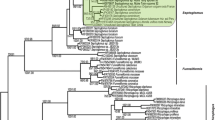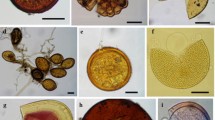Abstract
The last lowland locality ofGentiana verna in the Czech Republic is a calcareous grassland near Rovná at Strakonice in South Bohemia. This locality was the subject of a recovery programme that included support of the remaining population by micropropagation. The plants were inoculated with arbuscular mycorrhizal fungi (AMF) after their transfer toex vitro and the effect of AMF on their establishment and survival was studied. Although the conventional method of inoculation ofG. verna using spores or colonized root segments as an inoculum source resulted in no or negligible root colonization, the transplantation of gentians to the locality Rovná was successful and the plants became colonized with AMF very rapidly in the field. Successful mycorrhization of gentians under experimental conditions occurred only via the extraradical mycelial network established by neighbouring mycorrhizal plant species (nurse plant effect). Different nurse plant species formed different morphological types of mycorrhiza when inoculated with the same fungal isolate. Gentians always had theParis type of root colonization with intracellular hyphal loops and swellings. Intercellular hyphae, arbuscules and vesicles were not observed. No evidence for a positive growth response was found inG. verna.
Similar content being viewed by others
References
Azcón-Aquilar C., Encina C.L., Azcón R. &Barea J.M. (1994): Mycotrophy ofAnnona cherimola and the morphology of its mycorrhizae.Mycorrhiza 4: 161–168.
Barea J.M., Azcón R., Azcón-Aquilar C. (2002): Mycorrhizosphere interactions to improve plant fitness and soil quality.Antonie van Leeuwenhoed Int. J. Gen. Molec. Microbiol. 81: 343–351.
Bidartondo M.I., Redecker D., Hijri I., Wiemken A., Bruns T.D., Dominguez L., Sersic A., Leake J.R., Read D.J. (2002): Epiparasitic plants specialised on arbuscular mycorrhizal fungi.Nature 419: 389–392.
Brundrett M. &Kendrick B. (1990): The roots and mycorrhizas of herbaceous woodland plants. I. Quantitative aspects of morphology.New Phytol. 114: 457–468.
Brundrett M., Melville L. &Peterson L. (1994):Practical methods in mycorrhiza research. Mycologue Publications, Waterloo.
Cavagnaro T.R., Smith F.A., Ayling S.M., Smith S.E. (2003): Growth and phosphorus nutrition of aParis type arbuscular mycorrhizal symbiosis.New Phytol. 157: 127–134.
Demuth K., Forstreuter W. &Weber H.Ch. (1989): Cultivation of gentians and inoculation with AM-fungi.Angew. Bot. 63: 551–557.
Demuth K., Forstreuter W. &Weber H.Ch. (1991): Morphological differences in vesicular-arbuscular mycorrhizae ofGentianaceae produced by different endophytes.Flora 185: 127–132.
Demuth K. &Weber H.Ch. (1990): Strukturelle Inkompatibilität der vesikulär-arbuskulären Mycorrhizapilze in Enzianen (Gentianaceae).Angew. Bot. 64: 247–252.
Gallaud I. (1905): Études sur les mycorrhizes endotrophes.Rev. Gén. Bot. 17:5–48, 66–83, 123–136, 23–239, 313–325, 425–433, 479–500.
Guttenberger M. (2000): Arbuscules of vesicular-arbuscular mycorrhizal fungi inhabit an acidic compartment within plant roots.Planta 211: 299–304.
Halda J.J. (1996):The genus Gentiana. SEN, Dobré.
Harley J.L. &Harley E.L (1987): A check list of mycorrhiza in the british flora.New Phytol. 105: 1–102.
Imhof S. &Weber H.Ch. (1997): Root anatomy and mycotrophy (AM) of the achlorophyllousVoyria truncata (Standley)Standley & Steyermark (Gentianaceae).Bot. Acta 110: 127–134.
Jacquelinet-Jeanmougin S. &Gianinazzi-Pearson V. (1983): Endomycorrhizas in theGentianaceae. I. The fungi associated withGentiana lutea L.New Phytol. 95: 663–665.
Jacquelinet-Jeanmougin S., Gianinazzi-Pearson V., Gianinazzi S. (1987): Endomycorrhizas in theGentianaceae. II. Ultrastructural aspects of symbiont relationships inGentiana lutea L.Symbiosis 3: 269–286.
Knöbel M. &Weber H.Ch. (1988): Vergleichende Untersuchungen zur Mycotrophie beiGentiana verna L. undVoyria truncata (Stand.)Stand. & Stey. (Gentianaceae).Beitr. Biol. Pflanzen 63: 463–477.
Kojima T., Hayatsu M. &Saito M. (1998): Intraradical hyphae phosphatase of the arbuscular mycorrhizal fungus,Gigaspora margarita.Biol. Fertil. Soils 26: 331–335.
Kühn K.D. &Weber H.Ch. (1986): Zur vesikulären-arbuskulären Mycorrhizas vonGentiana asclepiadea L. (Gentianaceae) an natürlichen Standorten.Angew. Bot. 60: 427–439.
Malá J., Šíma P., Bylinský V. &Kirschnerová L. (2001): Mikropropagace pro záchranu hořce jarního a lýkovce vonného (Micropropagation used to preserveGentiana verna andDaphne cneorum).Příroda 19: 55–58.
Marx C., Dexheimer J., Gianinazzi-Pearson V. &Gianinazzi S. (1982): Enzymatic studies on the metabolism of vesicular-arbuscular mycorrhizas. IV. Ultracytoenzymological evidence (ATPase) for active transfer processes in the host-arbuscular interface.New Phytol. 90: 37–43.
McGee P.A. (1985): Lack of spread of endomycorrhizas ofCentaurium (Gentianaceae).New Phytol. 101: 451–458.
McGonigle T.P, Miller M.H., Evans D.G., Fairchild G.L. &Swan J.A. (1990): A new method, which gives an objective measure of colonisation of roots by vesicular-arbuscular mycorrhizal fungi.New Phytol. 115: 495–501.
Moore P.D. &Chapman S.B. (eds.) (1986):Methods in plant ecology. Blackwell Scientific Publications, Oxford.
Ocampo J.A. (1986): Vesicular-arbuscular mycorrhizal infection of “host” and “non-host” plants: effect on the growth responses of the plants and competition between them.Soil Biol. Biochem. 18: 607–610.
Phillips J.M. &Hayman D.S. (1970): Improved procedure for clearing roots and staining parasitic and AM fungi for rapid assessment of infection.Trans. Brit. Mycol. Soc. 55: 158–161.
Saito M., Stribley D.P. &Hepper Ch.M. (1993): Succinate dehydrogenase activity of external and internal hyphae of a vesicular-arbuscular mycorrhizal fungus,Glomus mosseae (Nicol. & Gerd.)Gerdmann andTrappe, during mycorrhizal colonisation of roots of leek (Allium porrum L.), as revealed by in situ histochemical staining.Mycorrhiza 4: 59–62.
Smith S.E. &Read D.J. (1997):Mycorrhizal symbiosis. Ed. 2. Academic Press, San Diego.
Smith F.A. &Smith S.E. (1996): Mutualism and parasitism: diversity in function and structure in the ‘arbuscular’ (VA) mycorrhizal symbiosis.Advances. Bot. Res. 22: 1–43.
Smith F.A. &Smith S.E. (1997): Structural diversity in (vesicular)-arbuscular mycorrhizal symbioses.New Phytol. 137: 373–388.
Sylvia D.M. (1988): Activity of external hyphae of vesicular-arbuscular mycorrhizal fungi.Soil Biol. Biochem. 20: 39–43.
Tisserant B., Gianinazzi-Pearson V., Gianinazzi S. &Gollotte A. (1993): In planta histochemical staining of fungal alkaline phosphatase activity for analysis of efficient arbuscular mycorrhizal infections.Mycol. Res. 97: 245–250.
Tutin T.G. et al. (edss.) (1968–1993):Flora europaea. Ed. 1, 2. Cambridge University Press, Cambridge.
Weber H.Ch., Klahr A. &Marron-Heimbuch M. (1995): Anatomical structures of the VA mycorrhizas in theApocynaceae (Gentianales).Bot. Acta 108: 525–534.
Walker C.M. &Trappe J.M. (1993): Names and epithets in theGlomales andEndogonales.Mycol. Res. 97: 339–344.
Yawney W.J. &Schulz R.C. (1990): Anatomy of a vesicular-arbuscular endomycorrhizal symbiosis between sugar maple (Acer saccharum Marsh) andGlomus etunicatum Becker & Gerdemann.New. Phytol. 114: 47–57.
Author information
Authors and Affiliations
Corresponding author
Rights and permissions
About this article
Cite this article
Sýkorová, Z., Rydlová, J. & Vosátka, M. Establishment of mycorrhizal symbiosis inGentiana verna . Folia Geobot 38, 177–189 (2003). https://doi.org/10.1007/BF02803150
Issue Date:
DOI: https://doi.org/10.1007/BF02803150




